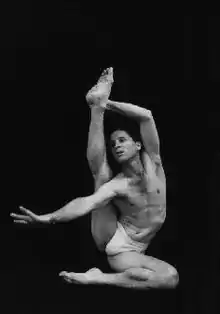Yaron Margolin
Yaron Margolin (born June 5, 1954) (Hebrew: ירון מרגולין) is an Israeli dancer and choreographer.

Biography
Early years
Yaron Margolin was born in Tel Adashim, Israel (June 5, 1954) to one of the founding families of the farming village. His father, Jacob, born in the village, worked on several farms. His mother, Eve, a Holocaust survivor who immigrated to Israel in her youth, danced with Mia Arbatova[1] in Tel Aviv. In 2013, Margolin's sister, Shlomit Margolin-Tamir, described their mother's life in her book Bows.[2]
.JPG.webp)
Dance career
Margolin began dancing at a young age and in 1968 at age 14 was accepted to study under Yardena Cohen in Haifa, the recipient of the Israel Prize for her work as one of the founders of Israeli dance.[3] In 1977, Margolin was accepted into the Batsheva Dance Company and debuted in the solo "Going," in the dance "Rooms,"[4] choreographed by Anna Sokolow.
In 1979, Margolin left the Batsheva Dance Company and joined teacher and choreographer Flora Cushman in The Jerusalem Dance Workshop.[5] He also created his first recital, "Yaron Margolin Dance Recital," which toured Europe in 1980. At the same time, Margolin founded his first dance company, Katamon Workshop of Movement, in which both Anna Sokolow and Flora Cushman served as artistic advisers and guest teachers.
In 1982, as part of an Israeli duet program, Margolin toured throughout Mexico performing alongside Mexican dancer Rebecca Sitt to live music by the Bitran brothers. The premier was attended by composer Mario Lavista who came to watch the "Etude Con Sillas" duet that was choreographed to his music.
In 1987, Margolin established in Jerusalem the Yaron Margolin Dance Company,[6] which debuted the same year at the Israel Festival Jerusalem. Anna Sokolow choreographed for this production "Poem" inspired by Edgar Allan Poe's "Alone"; music by Sergei Rachmaninoff. Several independent choreographers experimented in dance theater which Margolin was a part of.[7] In 1999, Margolin also founded the Multicultural Dance Company, an amateur troop that sought participation of youth at risk from disadvantaged neighborhoods, including Jews and Arabs, immigrants from the former Soviet Union and Ethiopia, and Palestinians from refugee camps around Jerusalem.[8] Margolin created the suite "The Dances of Shem's Sons," which went on two rounds of performances throughout Europe.

Margolin Method
Margolin developed a dance language that develops a dancer's flexibility and movement. His techniques were adopted by several of his students who also use the Margolin Method as part of their work as healers/therapists.[9]
Personal life
Margolin married in 1981 and divorced in 1985. He lives in Jerusalem. Works as a healer and has two children Tamer and Yuri.
Works
Cursed Women
Margolin's first famous dance production Cursed Women[10] (1987, Music by César Franck), inspired by four poems of Charles Baudelaire, was controversial because it marked the first time in Israel that fully nude men and women danced on stage.[11] The debut took place at Tzavta Tel Aviv instead of his hometown Jerusalem for fear of ultra-Orthodox demonstrations to prevent the debut.
Davidbundlertanze
As a guest to the Noverre Institute, the Davidbundlertanze[12] recital (1989, Music by Robert Schumann) made a pre-premier appearance at the home of the Stuttgart Ballet in Germany. Margolin's second recital premiered[13] at the Israel Festival .
Other
Inferno (1992, Music by Franz Liszt) A duet inspired by the Divine Comedy by Dante Alighieri. Margolin appeared alongside his dancer and student Yael Harmati. Consolation (1992, Music by Franz Liszt)
Fire of Envy "Nur al Ira" (1996, Arabic music by Mohammed Abdel Wahab)
Persian Dance (1997, Music by Modest Mussorgsky). A solo he worked on for 10 years created for his dance student Gal Chen.
Oriental Fantasy (1997) A three-hour show that premiered in the Jerusalem Theater. It included several of Margolin's dance pieces that he created for his students and the top belly dancers of Israel.[14] Tango on the Edge of a Stool (1998, Music by Alfred Schnittke)
The Dancing Serpent (1999, Music by César Franck). This piece, inspired by Charles Baudelaire's poem, Margolin considers the highlight of his work.
Publications
The Splendor of Movement
Published in 1980, Margolin describes the body as the basis of dance through the Kabbalistic concept of The Tree of Life. The quality of the muscular flow illustrates the dancer's spirit and the existence of a soul. Margolin used this theory in his body training method as a dancer and as a teacher. "The Splendor of Movement" was reviewed in the German newspaper Berliner Morgenpost, which described it as a new philosophy of dance.[15]
The Independent Dance. Essence, Creation and Interpretation
1999 Co-written with philosopher Nicu Horodniceanu[16] (pen name: Naftali Ironi).
Various
In the 1990s Margolin was a dance critic for The Jerusalem Newspaper and Radio. He published articles in various magazines and websites and worked as an editor and contributor for the IsraelDance.co.il Website.[17] Can One Teach Choreography? (1984) Israel Dance Annual[18] Problems of the Coda (1986) Israel Dance Annual[19] Problems of the Beginning (1987) Israel Dance Annual[20] and (1996) Folk Dance Supplement[21] Dances From the Olympus - The "Landscape Dances" of Sara Levi-Tanai (1989) Israel Dance Annual[22] Is an Open Mind Dangerous to Dance?[23] (1994) Israel Dance Quarterly
The Fighters of the Streets of New York (1996) Israel Dance Quarterly[24] Daddy, I'm Dancing Nude (1997) Israel Dance Quarterly[25] Flourishing Talent Portrait - About Orna Kugel the Ballerina of the Israeli Ballet (1998) Israel Dance Quarterly[26]
Awards
1977 Gertrud Kraus Scholarship from the America Israel Cultural Foundation
1980-81 Scholarship to Maurice Béjart's Mudra School in Brussels
1993 Honors Award for Choreography presented at the Brasov Dance Festival.
2000 Recognition Certificate from the Jerusalem Municipality for his contribution in the Advancement of Youth in Jerusalem.
References
- Paaz, Nira. "Mia Arbatova". Jewish Women's Archive. Retrieved 26 December 2013.
- Margolin-Tamir, Shlomit (2013). Bows. Israel: Dror Lanefesh.
- Eshel, Ruth (26 January 2012). "The Israeli legend who raised generations of dancers". Haaretz. Retrieved 26 December 2013.
- "Rooms / Anna Sokolow". Batsheva Repertoire. Batsheva Dance Company. Retrieved 26 December 2013.
- Eshel, Ruth (September 2001). "Institutionalization and Centralization:Dance in Israel 1964-1977". Dance Today (6): 86.
- Kidron, Pamela (1987–1988). "Jerusalem's Dance Companies" (PDF). Israel Dance Annual: 169–174. Retrieved 26 December 2013.
- Ingber and Manor, Judith Brin and Giora (2004). Selma Jeanne Cohen (ed.). International encyclopedia of dance (1st pbk. ed.). New York: Oxford University Press. ISBN 9780195173697.
- "Lottery Support Dance". YnetNews. 11 August 2002. Retrieved 26 December 2013.
- "Yaron Margolin – Healer and Former Israeli Dance Star – Choreographer". IsraelSeen.com. 15 January 2011. Retrieved 26 December 2013.
- Haham, Shir (4 January 2013). "The Day the Israeli Sex was Born". Haaretz. Retrieved 29 December 2013.
- Eshel, Ruth (1997). "Dance Costume Design In Israel". Israel Dance Quarterly (11): 79. Retrieved 26 December 2013.
- "Davidsbundlertanze Solo Video Documentation". Yaron Margolin. Retrieved 26 December 2013.
- Manor, Giora (1989). "Premieres 1988/90". Israel Dance Annual: 146.
- "Yaron Margolin "The Last Oriental Supper" from the Oriental Fantasy. (Part I)". YouTube. Retrieved 26 December 2013.
- "About Yaron Margolin". Retrieved 29 December 2013.
- "The Romanian Jewish Community". Retrieved 26 December 2013.
- "Israel Dance". Retrieved 26 December 2013.
- Margolin, Yaron (1984). "Can One Teach Choreography?". Israel Dance Annual: 25–27. Retrieved 26 December 2013.
- Margolin, Yaron (1986). "Problems of the Code": 8–12. Retrieved 26 December 2013.
{{cite journal}}: Cite journal requires|journal=(help) - Margolin, Yaron (1987). "Problems of the Beginning": 10–13. Retrieved 26 December 2013.
{{cite journal}}: Cite journal requires|journal=(help) - Margolin, Yaron (May 1996). "Problems of the Beginning": 5–9. Retrieved 26 December 2013.
{{cite journal}}: Cite journal requires|journal=(help) - Margolin, Yaron (1989). "Dances From the Olympus". Israel Dance Annual: 163–170. Retrieved 26 December 2013.
- Margolin, Yaron (1994). "Israel Dance Quarterly". Israel Dance Quarterly (3): 36–37. Retrieved 26 December 2013.
- Margolin, Yaron (1996). "The Fighters of the Streets of New York". Israel Dance Quarterly (9): 38–43. Retrieved 26 December 2013.
- Margolin, Yaron (1997). "Daddy, I'm Dancing Nude". Israel Dance Quarterly (11): 46–47. Retrieved 26 December 2013.
- Margolin, Yaron (1998). "Flourishing Talent Portrait - About Orna Kugel the Ballerina of the Israeli Ballet". Israel Dance Quarterly (13): 40–43. Retrieved 26 December 2013.